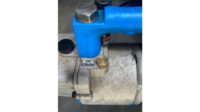When an outdoor condensing unit is installed in an area of the country where the outdoor temperature could drop lower than the evaporator’s temperature, it will generally use a pump-down system to control the operation of the compressor. This design will prevent refrigerant from migrating back to the compressor during the off cycle, when the compressor’s temperature is less than that of the evaporator.
Refrigerant migration can be damaging to a compressor. The refrigerant migrating back to the compressor will likely condense into a liquid, and on startup, the compressor will start with liquid refrigerant inside, which will lead to bearing washout and possibly slugging the compressor.
To prevent refrigerant migration, the temperature control will de-energize a solenoid installed in the liquid line, which will stop the flow of refrigerant to the metering device and into the evaporator. With the compressor still running, the refrigerant will be pumped out of the evaporator. When the low-side pressure gets to a value that ensures the refrigerant is sufficiently pumped out of the evaporator, a low-pressure switch will cycle the compressor off. Most systems will have the cut-out set at between 5 and 10 psig.
While servicing and maintaining these systems, verify that the pump-down operation is working as designed. Make sure the compressor is neither short cycling consistently during the off cycle, nor continuing to run with the liquid line solenoid closed and low-side operating below atmospheric pressure. Before leaving, cycle the system on its temperature control and watch the pump-down operation. The liquid line solenoid should close, causing the low-side pressure to drop and the compressor to then cycle off. It may cycle on one or two times to pump the refrigerant out of the evaporator, but it should not continually cycle on and off.
Some systems will incorporate a one-time pump out in its control logic, and in this case, the compressor should shut off and stay off. If the compressor continues to cycle on the low-pressure switch, there is an issue. If the compressor never shuts off and continues to run, there is also an issue. Both of these could cause damage to the compressor if left unattended.
CHECK OPERATION
To check the operation of the pump down, monitor the low-side pressure when the temperature control de-energizes the liquid line solenoid. If the low-side pressure drops below atmospheric pressure and the compressor does not cycle off, check the low-pressure switch — it is likely defective. If the compressor continues to cycle on the low-pressure switch, check the low-pressure settings (again, most will be set to cut-out at between 5 and 10 psig) and cut back on at a pressure that will ensure the switch will close during very low ambient temperatures without short cycling the compressor.
If the differential of the low-pressure switch is too narrow, it may need to be adjusted. If the low-pressure switch settings seem ok, verify that the liquid line solenoid is closing properly, front seat the king valve on the receiver, and watch the low-side pressure again. If the low-side drops and the compressor cycles off and stays off, the issue is with the liquid line solenoid valve. If the cycling of the compressor remains unchanged, the issue could be with the valves within the compressor bleeding back.
Verifying the proper operation of a pump-down system can save a compressor from being damaged, saving your customer money and adding to the value of your service.
See more articles from this issue here!




